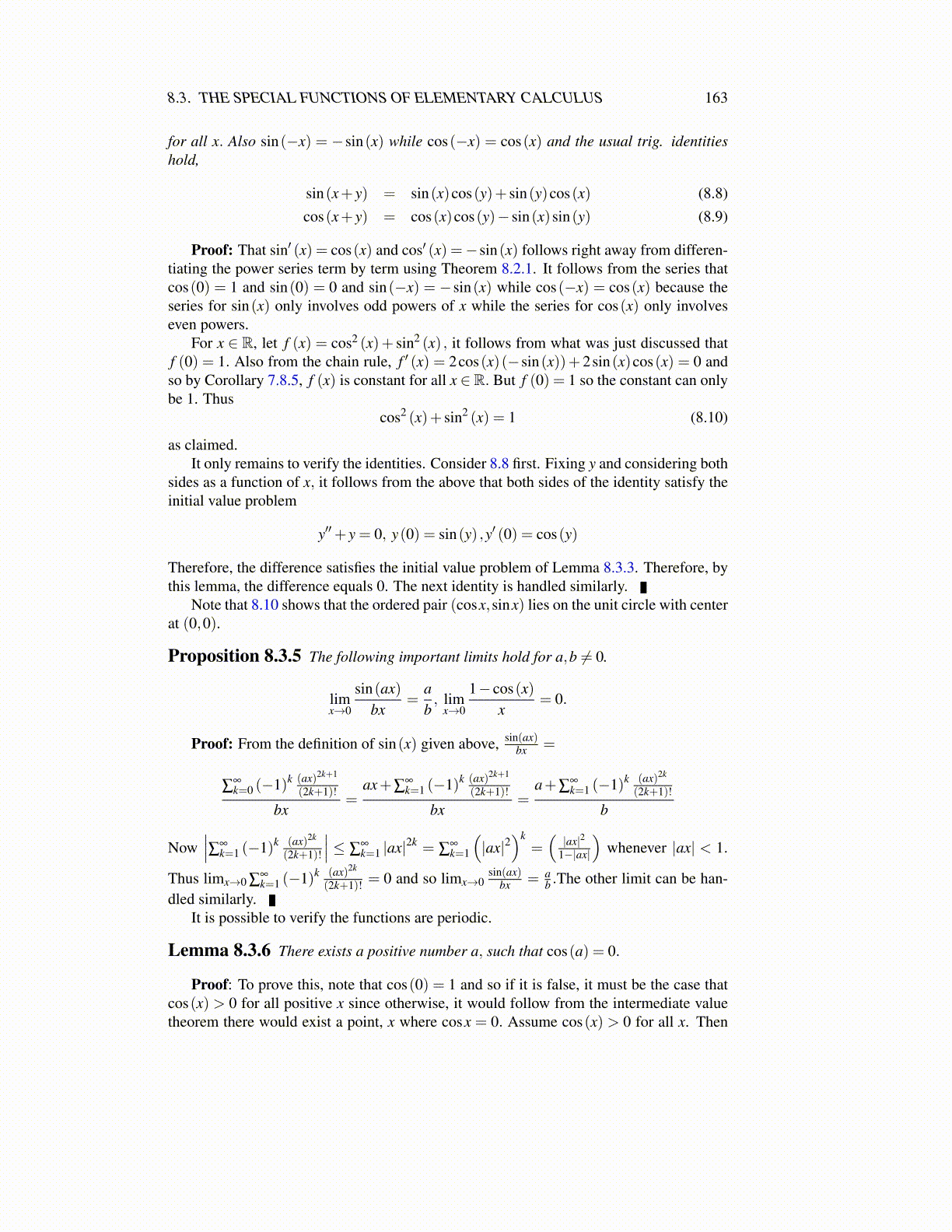
8.3. THE SPECIAL FUNCTIONS OF ELEMENTARY CALCULUS 163
Corollary 8.3.8 For all x ∈ R, sin(x+2π) = sin(x) , cos(x+2π) = cos(x)
Proof: Let y(x) ≡ sin(x+2π)− sin(x) . Then from the above, y′ (0) = y(0) = 0. It isalso clear from the above that y′′+ y = 0. Therefore, from Lemma 8.3.3 y = 0. Differenti-ating the identity just obtained yields the second identity.
Are these the same as the circular functions you studied very sloppily in calculus andtrigonometry? They are.
If sin(x) defined above and sin(x) studied in a beginning calculus class both satisfy theinitial value problem y′′+y = 0, y(0) = 0,y′ (0) = 1 then they must be the same. However,if you remember anything from calculus you will realize sin(x) used there does satisfy theabove initial value problem. If you don’t remember anything from calculus, then it doesnot matter about harmonizing the functions. Just use the definition given above in terms ofa power series. Similar considerations apply to cos .
Of course all the other trig. functions are defined as earlier. Thus
tanx =sinxcosx
, cotx≡ cosxsinx
, secx≡ 1cosx
, cscx≡ 1sinx
.
Using the techniques of differentiation, you can find the derivatives of all these.
8.3.2 The Exponential FunctionNow it is time to consider the exponential function exp(x) defined above. To do this, it isconvenient to have the following uniqueness theorem.
Lemma 8.3.9 Supposey′− y = 0, y(0) = 0
Then y = 0. Also for all x ∈ R, exp(−x)(exp(x)) = 1
Proof: The function exp has been defined above in terms of a power series. From thispower series and Theorem 8.2.1 it follows that exp solves the above initial value problem.Thus exp′ = exp . Multiply both sides of the differential equation by exp(−x) . Then us-ing the chain rule and product rule, d
dx (exp(−x)y(x)) = 0. and so exp(−x)y(x) = C, aconstant. The constant can only be 0 because of the initial condition. Therefore,
exp(−x)y(x) = 0 (∗)
for all x.Now I claim exp(−x) and exp(x) are never equal to 0. This is because by the chain
rule, abusing notation slightly,
(exp(−x)exp(x))′ =−exp(−x)exp(x)+ exp(−x)exp(x) = 0
and so exp(−x)exp(x) =C a constant. However, this constant can only be 1 because thisis what it is when x = 0, a fact which follows right away from the definition in terms ofpower series which implies exp(0) = 1. Thus from ∗,y(x) = 0.
Theorem 8.3.10 The function exp satisfies the following properties.
1. exp(x)> 0 for all x ∈ R, limx→∞ exp(x) = ∞, limx→−∞ exp(x) = 0.